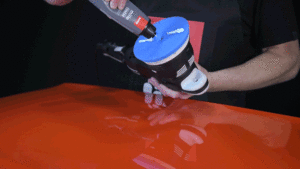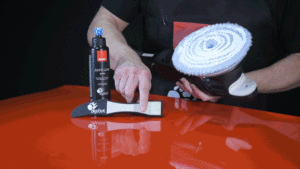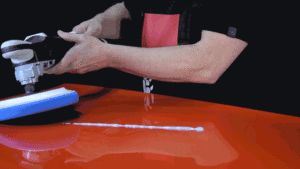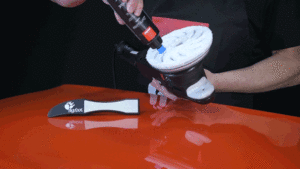Hey Mario,
Thanks for writing in with your question. With the introduction of the new tools and systems, there is a lot of new information we need to get out to our customers so your question is actually one we’ve seen a lot lately. All RUPES BigFoot Polishing Systems will benefit from priming the pads, however, the different movements of the systems and different designs of the pads will each require slightly different priming procedures. Regardless of which BigFoot System we are talking about, or which pad type, priming the pads serves the following functions:
- Brings the pad up to operating temperature (crucial for foam pads)
- Brings the compound up to operating temperature.
- Lubricates the pad and spreads polishing compound over the surface of the pad.
The combination of these three objectives will ensure that the polishing pads last longer, the user has a more comfortable and productive polishing experience, and that splatter/sling is minimized. Before priming any pad, make sure the surface is clean and free of debris or contamination. Brush, blow out with compressed air or vacuum the pads if necessary. New pads may have small remnants of fibers or foam stuck to them from the manufacturing process that you’ll want to remove. Used pads need to be inspected for debris, caked on compounds, or other contamination that may not have been removed when they were cleaned.
Now that we have a clean pad let’s take a look at the recommendations for each system movement:
- Gear-Driven Foam: The BigFoot Mille Gear-Driven Orbital Polisher moves the polishing pad in a unique pattern across the paint. This movement tends to transfer a lot of vibration to the operator. The vibration is often caused by a lack of proper lubrication by the compound and/or dry spots on the pad. These un-primed areas can be grabby, and that additional traction translates to vibration. By priming the Mille Foam Pads properly, much of this vibration can be eliminated. Regardless of the pad diameter, draw an “X” on the face of the pad. You can use then take the blade side of the BigFoot Claw Tool to help spread the polishing compound over the pad’s face. Your fingers or something like a hotel keycard will work too, but the Claw Tool is a great option.Next, set the Mille’s speed to 2 (or lower), and place it face down on the paint. Squeeze the trigger and polish a section about twice the size of the pad using just enough pressure to compress the pad slightly for approximately 30 seconds. Now inspect the pad, making sure that the polishing compound has begun to evenly coat the pad’s face. Add a little more compound to any dry areas and repeat if necessary for even coverage.

CLICK HERE to see compound application to Mille foam
- Wool on the Mille: The unique structure of our dual-action wool pads works best when each fiber is coated in polishing compound. Since the primary goal is coat all of the fiber’s of the wool pad, draw a thin layer of polishing compound over the pad’s face. You don’t want to over-saturate with a lot of polishing compound, but you do want to spread it as evenly as possible. Again, the bladed edge of the BigFoot Claw Tool is valuable at working the polishing compound into the nap of the wool. At this stage, you’re not worried about perfectly even coverage, but you do want to make sure that the compound is covering the majority of the pad face when you’re done spreading it out. Next, set the tool speed to 2 (or lower), and place it face down on the paint. Squeeze the trigger and polish a section about twice the size of the pad using just enough pressure to hold the wool firmly against the paint. Polish for approximately 15 seconds. Now inspect the pad, making sure that the polishing compound has evenly coated the pad’s face. Apply compound to any bare areas and repeat for another 15 seconds if necessary.

CLICK HERE to see wool priming with the Claw Tool
- Rotary Foam: The BigFoot Rotary requires a unique process to prime compared to the orbital movement of the other tools. The single-action spinning movement of the rotary means that we can effectively prime the pad in just one quick step with a little bit of practice. The method we recommend is known as “picking up a bead”. Draw a line of polishing compound on the paint, roughly the same length as the pad’s diameter. This is the bead. Set the rotary to speed 2 and place the rotary face down to the right of the bead. If this pad was like a clock, with 12 o’clock being straight up, 3 o’clock being to the right, 6 o’clock being straight down, and 9 o’clock being left, you would want the bead’s end to be somewhere around 10:30.Tilt the pad to the right slightly, so that it is tilted away from the bead of polish, like a mouth opening up ready to suck the polishing compound in. Squeeze the trigger and pass the pad over the bead, bringing the pad flat as the bead approaches the center of the pad. With a little practice, this will draw a spiral over the face of the pad and prime it in just one step. Not to mention it will impress friends who may not have used rotary before. Side note – the first few times you practice this technique I would recommend wearing your BigFoot Polishing Apron and covering any valuable items as you’re likely to create a little bit of a mess until you master the technique to avoid sling.

CLICK HERE to see a bead pickup with rotary
- Random Orbital Foam: To harness the impressive power created by the large-diameter orbital movement of the BigFoot Random Orbital Polishers and turn it into swirl-eliminating polishing ability, it is necessary to use dense foam for BigFoot Random Orbital Polishing Pads. The dense foam formulas really benefit from correct priming procedures. Typically if we ever receive complaints about the performance of random orbital foam pads we can trace the root cause back to the operator not following a proper priming procedure with them.For the 150mm and 180mm (6 and 7 inch) diameter BigFoot Random Orbital Foam Pads, place 4-6 pea-sized drops of polishing compound around the outer third. On the 100mm (4 inch) diameter pads use 1-3 pea-sized drops, and on the 70mm and 50mm Nano-sized pads, use 1 tiny drop in the center of the pad.Next, set the polisher’s speed to 2, and place it face down on the paint. Squeeze the trigger and polish a section about twice the size of the pad using just enough pressure to compress the pad slightly for approximately 30 seconds. Now inspect the pad, making sure that the polishing compound has begun to evenly coat the pad’s face. Repeat if necessary for even coverage or if the more aggressive foam pads remain stiff. You’ll find with the coarser pads you may need more time if the ambient temperatures are on the cooler side. Remember, one of the key reasons for priming was to bring the pad up to a proper operating temperature, so adjust your technique to compensate with either more time, a slightly higher speed setting, or a tiny bit more downward pressure to introduce more heat into the foam. Until it is softened up the foam will not contour properly to the panel and it may produce a rough or choppy experience for the operator. Conversely, reduce time, speed, or pressure if you are working in a hot environment as you will not need much heat to soften the foam or start the compound migration around the pad.
- Microfiber Pads: Microfiber, by design, likes to hold onto things and one of those things is polishing compound. Because of the fiber’s natural inclination and the design of the BigFoot Microfiber Pads, it requires a little different approach. Apply BigFoot polishing compound to the microfiber pad in a thin even coat, much like coloring with a crayon. You don’t need a lot of polishing compound, but you want to get as even as a coat as possible. With the slot cuts in our pad design, we find it helpful to simply trace around the face of the pad with the compound bottle, applying a thin line to every area, avoiding the slot cuts.Just like with the other pads, it may be beneficial to spread the polishing compound over the pad using the bladed edge of the BigFoot Claw Tool. Next, set the random orbital polisher’s speed to 2 and place it face down on the paint. Polish a section about twice the size of the pad for about 15 seconds. Now inspect the pad, making sure that the polishing compound has evenly coated the pad’s face. Apply compound to any bare areas and repeat for another 15 seconds if necessary.The grabby nature of microfiber may require a few applications to get even coverage.

CLICK HERE to see compound application to microfiber pads
- Wool on Random Orbital: Using the BigFoot Wool Pads on the Random Orbital requires a similar technique to the microfiber pads. However, the polishing compound will flow over the wool fibers easier than it does with the microfiber, usually making the process a little quicker to complete with less re-application. Apply BigFoot polishing compound to the wool pad in a thin even coat. You don’t need a lot of polishing compound, but you want as even as a coat as possible.Again, it may be beneficial to spread the polishing compound over the pad using the bladed edge of the BigFoot Claw Tool. Next, set the random orbital polisher’s speed to 2 and place it face down on the paint. Polish a section about twice the size of the pad for approximately 15 seconds. Now inspect the wool pad, making sure that the polishing compound has evenly coated the pad’s face. Apply compound to any bare areas and repeat for another 15 seconds if necessary.
I know, it is a lot of information to cover, but remember the primary goals are to warm the pad and polishing compound up to operating temperature as well as coat the face of the pad with polishing compound. Foam pads are more sensitive to warming up compared to fiber pads where microfiber and wool pads require more care to make sure they are evenly coated. As long as you can keep those two concepts in mind you’ll be fine.
Thanks again for writing in with your question Mario. I’m sure this will be beneficial information to everyone out there and your gift from RUPES will be on its way to you soon.
Yours in better polishing,
Todd Helme | Senior Technical Advisor, RUPES USA

 Foam vs. Microfiber vs. Wool: Polishing Pad Comparisons
Foam vs. Microfiber vs. Wool: Polishing Pad Comparisons
Connect With Us